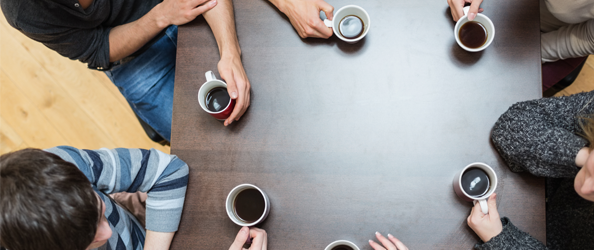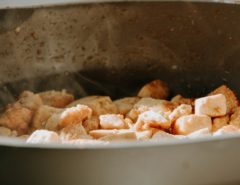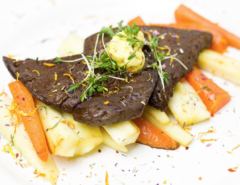By: Amelia Chen
Large family events can be exhausting and hectic and entertaining, so what better way to encourage everyone – well, the adults – to unwind than with a festive cocktail. I could start to delve into the art and science of various cocktails, but there are more subtle ways to sneak alcohol into the holiday dinner spread.
Alcohol works to improve flavors and aromas and sometimes textures of food. Because it is a polar and very volatile molecule, it is able to interact with both fat and water soluble molecules to bring aromas to our senses more quickly. These two properties are the recurring themes of cooking with alcohol.
Flambéd banasa. Image sourced from tamarindodailyphoto.blogspot.com
Flambe sounds better than just saying that you drenched your food in alcohol and lit it on fire. The fire immediately burns off the alcohol, leaving behind the aroma and flavor without the harshness of liquor, while also browning the food. It’s definitely an impressive display but probably not the safest technique to execute in a crowded home, but if for whatever reason somebody has a craving for bananas foster or cherries jubilee, it can be done. It has been shown that igniting the liquor actually does little for removing ethanol, and temperatures don’t get high enough for Maillard browning reactions. Simply heating on the stove removes more ethanol than igniting the liquor.

Vodka pie crust. Photo sourced seriouseats.com
Pies are an obvious choice for holiday desserts. But making a perfect crust at home can be a daunting task, especially with all the conflicting advice in the foodie-sphere. It only takes three ingredients: flour, fat, water. Yet creating the perfect pie crust that is flakey and light is challenging because the ratio of ingredients needs to be just right. Water aids in gluten formation in flour and overkneading can result in a tough dough, but Cook’s Illustrated has a solution that is already backed by Alton Brown and several food bloggers. Vodka. Yes, vodka pie crust. Since it is only about 60% water and gluten doesn’t form in ethanol, vodka makes it easier to bring the dough together (hopefully) without ruining the crust. During baking, most of the ethanol is cooked off, and using another liquor such as bourbon leaves behind flavors that would complement the filling such as sweet potato.

Beer battered goodness. Image sourced recipe.com
What do fish and waffles, pickles and cake, and cheese curds and beignets have in common? All begin with a batter that could benefit from some beer. Beer battered foods are remarkably crispy and tender. And adding beer to batters makes an airier dessert. As an ingredient, beer provides carbon dioxide, foaming agents, and of course, alcohol. The bubbles in beer expand the batter to give that light texture before it even hits the hot oil or pan or oven, and with the presence of foaming agents, the bubbles are protected from bursting right away. Meanwhile, ethanol evaporates faster than water, resulting in shorter cooking times and crispier texture.

Red wine is perfect for sauces.
I like to keep a bottle each of red and white wine on hand for sauces and marinades. Since alcohol can form molecular bonds, it mixes and mingles with those molecules that aren’t totally fat or water soluble to carry flavors from sauce or marinade into the food. As an added bonus, ethanol also denatures some proteins, which acts to tenderize meat. So add a splash of white wine to that tomato sauce (after sauteing the aromatics and before adding the tomatoes) or a bit of red with the beef marinade. And if you thought the action of ethanol would only last as long as the short time it takes for it to evaporate off in the cooking process, the good (or bad, possibly) news is that small amounts of alcohol is actually still retained even after a couple hours of simmering.
References
Durand, F. “Recipe Review: The Cook’s Illustrated Vodka Pie Crust.” 6 November 2008. TheKitchn.com. <http://www.thekitchn.com/recipe-review-vodka-pie-crust-68851> > 23 November 2015.
Eplett, L. “How Alcohol Makes a Flakier Pie Crust: The ‘Proof’ Is in the Pie.” 14 March 2014. ScientificAmerican.com. <http://blogs.scientificamerican.com/food-matters/how-alcohol-makes-a-flakier-pie-crust-the-proof-is-in-the-pie/ > 23 November 2015.
Gibbs, W. W., Myhrvold, N. “Beer Batter is Better.” 18 January 2011. ScientificAmerican.com. <http://www.scientificamerican.com/article/beer-batter-is-better/> 23 November 2015.
Hansen, C.E., Kwasniewski, M.T., Sacks, G.L. (2012). Decoupling the effects of heating and flaming on chemical and sensory changes during flambe cooking. International Journal of Gastronomy and Food Science, 1: 90-95.
Weeks, K.D. “Spirited Cooking: Keep Some Liquor in the Kitchen.” 20 January 2010. <http://www.npr.org/templates/story/story.php?storyId=122730434> 23 November 2015.
“Alcohol’s Role in Cooking.” 26 February 2010. <http://www.finecooking.com/item/13810/alcohols-role-in-cooking> 23 November 2015.






Leave a Reply